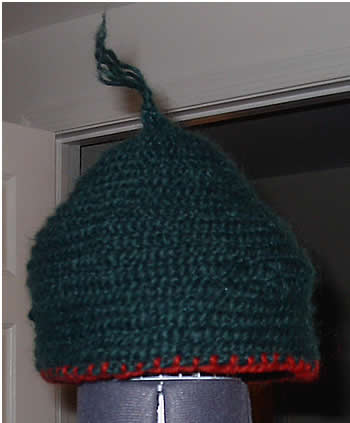 |
 Modelled here by its creator* |
After taking a class at the Feb '03 University of Atlantia #58 from Mistress Bronach Nalbrjotr on Basic Nalbinding, I decided to make something useful. I did many practice pieces of tubes and worms and circles to get an idea of how the stitch worked. As I do not remember the name of the stitch she taught us, I think it is the Oslo stitch based on other documentation I have consulted.
Process:
I started this hat on 5/14/2003 and completed it on 5/17/2003. I used a green Lopi yarn from Halcyon Yarns, because the bulky seems to work better with nalbinding. I started working on the brim first and after doing several rows of a large tube, I started decreasing every 10 stitches, decreasing every 5 and then 3 towards the top. This ended up making the crown of the hat too shallow when I got to the tip of the hat. After I completed the tip, I started casting on more stitches and created a longer brim so that it would actually cover my head and ears instead of looking like a beanie. I ended up putting a length of yarn through the top and tying a knot to make a little tassle instead of just one string poking up. Finally I did a buttonhole stitch with the red yarn as a little finishing for the edge.
Resources:
There are two extant examples of supposed headgear made with nalbinding. One is a 9th - 10th century Coptic hat with a shallow brim and a long tassle [Hald p.308]. The other is called a hair milk strainer [Hald p.286] (which confuses me) but it sounds like it was intended for headwear. Neither of them look like mine. Surviving examples of nalbinding include mittens, socks, and these two head coverings. As this is my first piece, it is not entirely documentable, but feasible since hats have been found, and it would have been a quick and easy way to make headcovering.
The Oslo Stitch type I used is also Margrethe Hald's Type IIa, from Ancient Danish Textiles from Bogs and Burials [p.285]. Nordland's notation calls this stitch 4[12]. Hansen's notation calls it UO/UOO F1. Larry Schmitt calls it "Oslo stitch", which I read in his book Lessons in Nålbinding: Lots of Socks. Thora says on her site: "As Viking nålebinding goes, this is a commonly occurring stitch, with at least three known and geographically disparate examples, all mittens."
Mistress Thora shows great examples of many of the stitches, including the Oslo stitch, on her site: http://www.cs.vassar.edu/~capriest/nalebind.html
Bibliography:
Hald, Margrethe. Ancient Danish Textiles from Bogs and Burials. National Museum of Denmark, Copenhagen, 1980. ISBN 87-480-0312-3.
Schmitt, Larry. Lessons in Nålbinding: Lots of Socks. Cottage Grove, Wisconsin: Lawrence W. Schmitt, 2000.
Priest-Dorman, Carolyn. Nålebinding Techniques in the Viking Age. 2001 http://www.cs.vassar.edu/~capriest/nalebind.html
*And let me tell you about taking a picture of yourself modeling the hat because you can't wait for morning, but don't want to wake up your sleeping sweetie. I set the digital camera to look using the LCD screen. Then I held the camera up to a mirror to check on proper alignment using the reflection and then hit the button. :) Not too shabby if I say so myself.
... Yes, I realize that I made a great warm wool hat just in time for Summer.